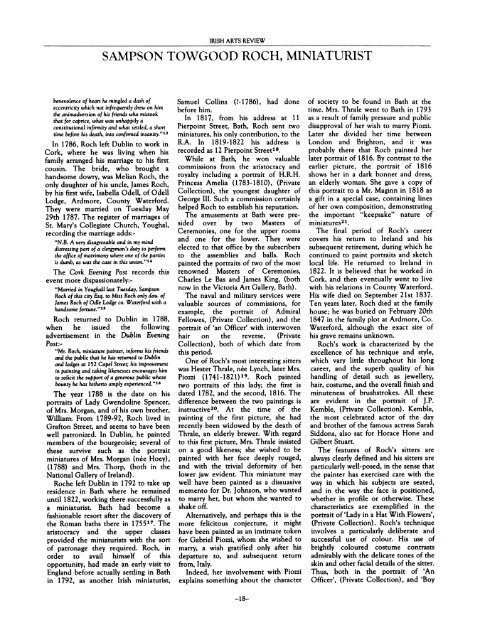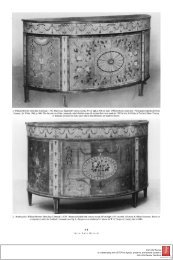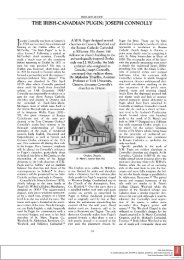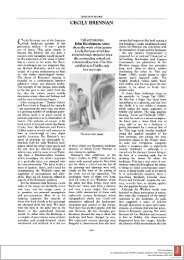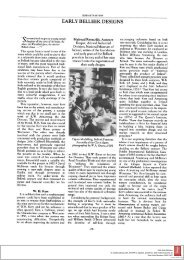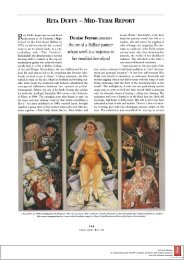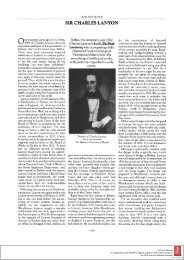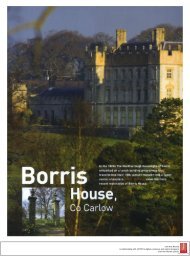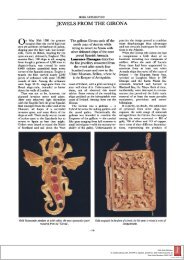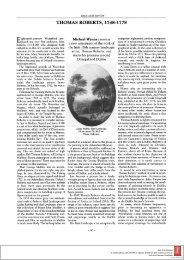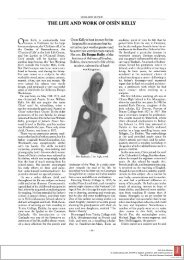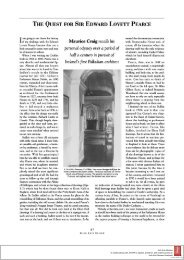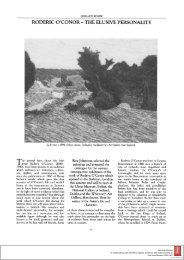SAMPSON TOWGOOD ROCH, MINIATURIST
SAMPSON TOWGOOD ROCH, MINIATURIST
SAMPSON TOWGOOD ROCH, MINIATURIST
You also want an ePaper? Increase the reach of your titles
YUMPU automatically turns print PDFs into web optimized ePapers that Google loves.
IRISH ARTS REVIEW<br />
<strong>SAMPSON</strong> <strong>TOWGOOD</strong> <strong>ROCH</strong>, <strong>MINIATURIST</strong><br />
benevolence of heart he mingled a dash of<br />
eccentricity which not infrequently drew on him<br />
the animadversion of his friends who mistook<br />
that for caprice, what was unhappily<br />
a<br />
constitutional infirmity and what settled, a short<br />
time before his death, into confirmed insanity"13<br />
In 1786, Roch left Dublin to work in<br />
Cork, where he was living when his<br />
family arranged his marriage to his first<br />
cousin. The bride, who brought<br />
a<br />
handsome dowry, was Melian Roch, the<br />
only daughter of his uncle, James Roch,<br />
by his first wife, Isabella Odell, of Odell<br />
Lodge, Ardmore, County Waterford.<br />
They were married on Tuesday May<br />
29th 1787. The register of marriages of<br />
St. Mary's Collegiate Church, Youghal,<br />
recording the marriage adds:<br />
"N.B. A vety disagreeable and in my mind<br />
event<br />
distressing part of a clergyman's duty to perform<br />
the office of matrimony where one of the parties<br />
is dumb, as was the case in this union."14<br />
The Cork Evening Post records this<br />
more<br />
dispassionately:<br />
"Married in Youghall last Tuesday, Sampson<br />
Roch of this city Esq. to Miss Roch only dau. of<br />
James Roch of Odie Lodge co. Waterford with a<br />
handsome fortune."15<br />
Roch returned to Dublin in 1788,<br />
when he issued the following<br />
advertisement in the Dublin Evening<br />
Post.<br />
"Mr. Roch, miniature painter, informs his friends<br />
and the public that he has returned to Dublin<br />
and lodges at ? 52 Capel Street; his improvement<br />
in painting and taking likenesses encourages him<br />
to solicit the support of a generous public whose<br />
bounty he has hitherto amply experienced."16<br />
The year 1788 is the date on his<br />
portraits of Lady Gwendoline Spencer,<br />
of Mrs. Morgan, and of his own brother,<br />
William. From 1789-92, Roch lived in<br />
Grafton Street, and seems to have been<br />
well patronized. In Dublin, he painted<br />
members of the bourgeoisie; several of<br />
these survive such as the portrait<br />
miniatures of Mrs. Morgan (n?e Hoey),<br />
(1788) and Mrs. Thorp, (both in the<br />
National Gallery of Ireland).<br />
Roche left Dublin in 1792 to take up<br />
residence in Bath where he remained<br />
until 1822, working there successfully as<br />
a miniaturist. Bath had become a<br />
fashionable resort after the discovery of<br />
the Roman baths there in 175517. The<br />
aristocracy and the upper classes<br />
provided the miniaturists with the sort<br />
of patronage they required. Roch, in<br />
order to avail himself of this<br />
opportunity, had made an early visit to<br />
England before actually settling in Bath<br />
in 1792, as another Irish miniaturist,<br />
Samuel Collins (?-1786), had done<br />
before him.<br />
In 1817, from his address at 11<br />
Pierpoint Street, Bath, Roch sent two<br />
miniatures, his only contribution, to the<br />
R.A. In 1819-1822 his address is<br />
recorded as 12 Pierpoint Street18.<br />
While at Bath, he won valuable<br />
commissions from the aristocracy and<br />
royalty including a portrait of H.R.H.<br />
Princess Amelia (1783-1810), (Private<br />
Collection), the youngest daughter of<br />
George III. Such a commission certainly<br />
helped Roch to establish his reputation.<br />
The amusements at Bath were pre<br />
sided over by two Masters of<br />
Ceremonies, one for the upper rooms<br />
and one for the lower. They were<br />
elected to that office by the subscribers<br />
to the assemblies and balls. Roch<br />
painted the portraits of two of the most<br />
renowned Masters of Ceremonies,<br />
Charles Le Bas and James King, (both<br />
now in the Victoria Art Gallery, Bath).<br />
The naval and military services were<br />
valuable sources of commissions, for<br />
example, the portrait of Admiral<br />
Fellowes, (Private Collection), and the<br />
portrait of 4an Officer' with interwoven<br />
hair on the reverse, (Private<br />
Collection), both of which date from<br />
this period.<br />
One of Roch's most interesting sitters<br />
was Hester Thrale, n?e Lynch, later Mrs.<br />
Piozzi (1741-1821)19. Roch painted<br />
two portraits of this lady; the first is<br />
dated 1782, and the second, 1816. The<br />
difference between the two paintings is<br />
instructive20. At the time of the<br />
painting of the first picture, she had<br />
recently been widowed by the death of<br />
Thrale, an elderly brewer. With regard<br />
to this first picture, Mrs. Thrale insisted<br />
on a good likeness; she wished to be<br />
painted with her face deeply rouged,<br />
and with the trivial deformity of her,<br />
lower jaw evident. This miniature may<br />
well have been painted as a dissuasive<br />
memento for Dr. Johnson, who wanted<br />
to marry her, but whom she wanted to<br />
shake off.<br />
Alternatively, and perhaps this is the<br />
more felicitous conjecture, it might<br />
have been painted<br />
as an imtimate token<br />
for Gabriel Piozzi, whom she wished to<br />
marry? a wish gratified only after his<br />
departure to, and subsequent<br />
return<br />
from, Italy.<br />
Indeed, her involvement with Piozzi<br />
explains something about the character<br />
of society to be found in Bath at the<br />
time. Mrs. Thrale went to Bath in 1793<br />
as a result of family pressure and public<br />
disapproval of her wish to marry Piozzi.<br />
Later she divided her time between<br />
London and Brighton, and it was<br />
probably there that Roch painted her<br />
later portrait of 1816. By contrast to the<br />
earlier picture, the portrait of 1816<br />
shows her in a dark bonnet and dress,<br />
an<br />
elderly<br />
woman. She gave a copy of<br />
this portrait to a Mr. Maginn in 1818 as<br />
a gift in a special case, containing lines<br />
of her own composition, demonstrating<br />
the important "keepsake" nature of<br />
miniatures21.<br />
The final period of Roch's career<br />
covers his return to Ireland and his<br />
subsequent retirement, during which he<br />
continued to paint portraits and sketch<br />
local life. He returned to Ireland in<br />
1822. It is believed that he worked in<br />
Cork, and then eventually went to live<br />
with his relations in County Waterford.<br />
His wife died on September 21st 1837.<br />
Ten years later, Roch died at the family<br />
house; he was buried on February 20th<br />
1847 in the family plot at Ardmore, Co.<br />
Waterford, although the exact site of<br />
his grave remains unknown.<br />
Roch's work is characterized by the<br />
excellence of his technique and style,<br />
which vary little throughout his long<br />
career, and the superb quality of his<br />
handling of detail such as jewellery,<br />
hair, costume, and the overall finish and<br />
minuteness of brushstrokes. All these<br />
are evident in the portrait of J.P.<br />
Kemble, (Private Collection). Kemble,<br />
the most celebrated actor of the day<br />
and brother of the famous actress Sarah<br />
Siddons, also sat for Horace Hone and<br />
Gilbert Stuart.<br />
The features of Roch's sitters are<br />
always clearly defined and his sitters are<br />
particularly well-posed, in the sense that<br />
the painter has exercised care with the<br />
way in which his subjects are seated,<br />
and in the way the face is positioned,<br />
whether in profile<br />
or otherwise. These<br />
characteristics are exemplified in the<br />
portrait of 'Lady in a Hat With Flowers',<br />
(Private Collection). Roch's technique<br />
involves a particularly deliberate and<br />
successful use of colour. His use of<br />
brightly coloured costume contrasts<br />
admirably with the delicate tones of the<br />
skin and other facial details of the sitter.<br />
Thus, both in the portrait of 4An<br />
Officer', (Private Collection), and 'Boy<br />
-18


